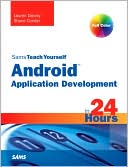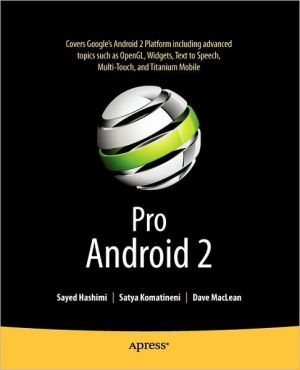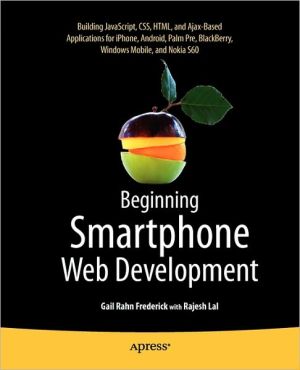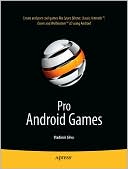Sams Teach Yourself Android Application Development in 24 Hours
Search in google:
Full Color!In just 24 sessions of one hour or less, learn how to build powerful applications for the world’s first complete, open, and free mobile platform: Android. Using this book’s straightforward, step-by-step approach, you’ll build a fully-featured Android application from the ground up and master the skills you need to design, develop, test, and publish powerful applications. Each lesson builds on what you’ve already learned, giving you a rock-solid foundation for real-world success!Step-by-step instructions carefully walk you through the most common Android development tasks.Quizzes and Exercises at the end of each chapter help you test your knowledge.By the Way notes present interesting information related to the discussion.Did You Know? tips offer advice or show you easier ways to perform tasks.Watch Out! cautions alert you to possible problems and give you advice on how to avoid them.Learn how to… Develop Android applications quickly and successfully with Java Master Google’s Android SDK and development tools Leverage the Eclipse programming environment to develop Android projects Understand the Android application lifecycle Build effective, user-friendly user interfaces Retrieve, store, and work with application data Develop powerful network applications Add popular social features and location-based services to your applications Take advantage of Android device hardware like the camera Internationalize, test, and publish your Android applications
Introduction 1Part I: Android FundamentalsHOUR 1: Getting Started with Android 7Introducing Android 7Familiarizing Yourself with Eclipse 9Running and Debugging Applications 17Summary 23Q&A 23Workshop 24HOUR 2: Mastering the Android Development Tools 27Using the Android Documentation 27Debugging Applications with DDMS 29Working with the Android Emulator 35Using Other Android Tools 38Summary 39Q&A 40Workshop 40HOUR 3: Building Android Applications 43Designing a Typical Android Application 43Using the Application Context 46Working with Activities 47Working with Intents 51Working with Dialogs 53Logging Application Information 54Summary 55Q&A 55Workshop 56HOUR 4: Managing Application Resources 59Using Application and System Resources 59Working with Simple Resource Values 63Working with Drawable Resources 66Working with Layouts 67Working with Files 71Working with Other Types of Resources 73Summary 73Q&A 74Workshop 75HOUR 5: Configuring the Android Manifest File 77Exploring the Android Manifest File 77Configuring Basic Application Settings 81Defining Activities 86Managing Application Permissions 88Managing Other Application Settings 91Summary 91Q&A 92Workshop 93HOUR 6: Designing an Application Framework 95Designing an Android Trivia Game 95Implementing an Application Prototype 102Running the Game Prototype 107Summary 109Q&A 110Workshop 110Part II: Building an Application FrameworkHOUR 7: Implementing an Animated Splash Screen 113Designing the Splash Screen 113Implementing the Splash Screen Layout 114Working with Animation 119Summary 123Q&A 124Workshop 124HOUR 8: Implementing the Main Menu Screen 127Designing the Main Menu Screen 127Implementing the Main Menu Screen Layout 131Working with the ListView Control 134Working with Other Menu Types 138Summary 141Q&A 141Workshop 141HOUR 9: Developing the Help and Scores Screens 143Designing the Help Screen 144Implementing the Help Screen Layout 145Working with Files 147Designing the Scores Screen 149Implementing the Scores Screen Layout 151Designing a Screen with Tabs 154Working withSummary 158Q&A 158Workshop 159HOUR 10: Building Forms to Collect User Input 161Designing the Settings Screen 161Implementing the Settings Screen Layout 165Using Common Form Controls 167Saving Form Data with SharedPreferences 175Summary 178Q&A 178Workshop 179HOUR 11: Using Dialogs to Collect User Input 181Working with Activity Dialogs 181Using DatePickerDialog 184Working with Custom Dialogs 187Summary 194Q&A 194Workshop 194HOUR 12: Adding Application Logic 197Designing the Game Screen 197Implementing the Game Screen Layout 200Working with ViewSwitcher Controls 203Wiring Up Game Logic 208Summary 214Q&A 215Workshop 215Part III: Enhancing Your Application with Powerful Android FeaturesHOUR 13: Working with Images and the Camera 217Designing the Avatar Feature 217Adding an Avatar to the Settings Screen Layout 219Working with ImageButton Controls 221Working with Image Media 223Working with Bitmaps 228Summary 230Q&A 230Workshop 231HOUR 14: Adding Support for Location-Based Services 233Designing the Favorite Place Feature 233Implementing the Framework for the Favorite Place Feature 237Using Location-Based Services 240Using Geocoding Services 246Working with Maps 248Summary 251Q&A 251Workshop 252HOUR 15: Adding Network Support 255Designing Network Applications 255Developing Network Applications 257Accessing Network Services 260Indicating Network Activity with Progress Bars 262Running Tasks Asynchronously 265Downloading and Displaying Scores 267Downloading and Parsing Question Batches 271Summary 274Q&A 274Workshop 274HOUR 16: Adding More Network Support 277Determining Data to Send to the Server 277Accessing Phone Status Information 278Uploading Data to a Remote Application Server 281Summary 289Q&A 289Workshop 289HOUR 17: Adding Social Features 291Enhancing Your Application with Social Features 291Adding Friend Support to Your Application 292Integrating with Social Networking Services 300Summary 302Q&A 302Workshop 303HOUR 18: Creating a Home Screen App Widget 305Designing an App Widget 305Handling App Widget User Events 313Working with Widget Background Operations 314Summary 318Q&A 318Workshop 319Part IV: Adding Polish to Your Android ApplicationHOUR 19: Internationalizing Your Application 321General Internationalization Principles 321How Android Localization Works 322Android Internationalization Strategies 327Using Localization Utilities 329Summary 330Q&A 331Workshop 332HOUR 20: Developing for Different Devices 333Configuration Management for Android 333Summary 343Q&A 343Workshop 344HOUR 21: Diving Deeper into Android 347Exploring More Core Android Features 347Designing Advanced User Interfaces 349Working with Multimedia 353Working with 2D and 3D Graphics 354Personalizing Android Devices 356Managing and Sharing Data 358Accessing Underlying Device Hardware 362Summary 364Q&A 364Workshop 365HOUR 22: Testing Android Applications 367Testing Best Practices 367Maximizing Test Coverage 371Summary 380Q&A 380Workshop 381Part V: Publishing Your ApplicationHOUR 23: Getting Ready to Publish 383Understanding the Release Process 383Preparing the Release Candidate Build 385Testing the Application Release Candidate 386Packaging and Signing an Application 387Testing the Signed Application Package 390Summary 392Q&A 392Workshop 393HOUR 24: Publishing on the Android Market 395Selling on the Android Market 395Exploring Other Android Publishing Options 402Summary 405Q&A 405Workshop 406Part VI: AppendixesAPPENDIX A: Configuring Your Android Development Environment 409Development Machine Prerequisites 409Installing the Java Development Kit 410Installing the Eclipse IDE 410Installing the Android SDK 411Installing and Configuring the Android Plug-in for Eclipse (ADT) 412Upgrading the Android SDK 413Configuring Development Hardware for Device Debugging 413APPENDIX B: Eclipse IDE Tips and Tricks 415Creating New Classes and Methods 415Organizing Imports 415Documenting Code 416Using Auto-Complete 416Editing Code Efficiently 416Renaming Almost Anything 417Formatting Code 418Organizing Code 418Fun with Refactoring 418Resolving Mysterious Build Errors 420Creating Custom Log Filters 420Moving Tabs Around 421Integrating Source Control 421APPENDIX C: Supplementary Materials 423Accessing the Publisher’s Website 423Accessing the Authors’ Website 424Contacting the Authors 425Leveraging Online Android Resources 425Index 427







